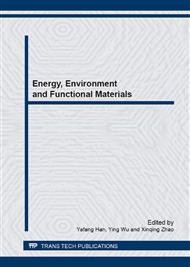p.18
p.23
p.31
p.35
p.41
p.46
p.52
p.58
p.65
Facile Synthesis of Highly Ordered Macroporous CeO2 Film for Methylene Blue Degradation
Abstract:
Negative-charged PS microspheres were prepared through emulsifier-free emulsion polymerization method. High-quality PS colloidal crystals were obtained via the horizontal deposition method. Hierarchically ordered macroporous CeO2 sheets were fabricated on fluorine-doped tin oxide (FTO) substrates using PS colloidal crystals as template by a continuous infiltration process. The structure and morphology of the products were characterized by X-ray diffractometer (XRD), scanning electron microscopy (SEM), high resolution transmission electron microscopy (HRTEM) and nitrogen adsorption-desorption. The characterized results showed that macroporous CeO2 sheets replicated well three-dimensionally (3D) ordered structure derived from PS colloidal crystals template and possessed a relatively large specific surface area. Moreover, the synthesized hierarchical CeO2 sheets showed the highest photocatalytic activity under solar irradiation and also exhibited remarkable ability to remove methylene blue, suggesting they are promising catalyst for wastewater treatment.
Info:
Periodical:
Pages:
41-45
Citation:
Online since:
April 2014
Authors:
Keywords:
Price:
Сopyright:
© 2014 Trans Tech Publications Ltd. All Rights Reserved
Share:
Citation:


